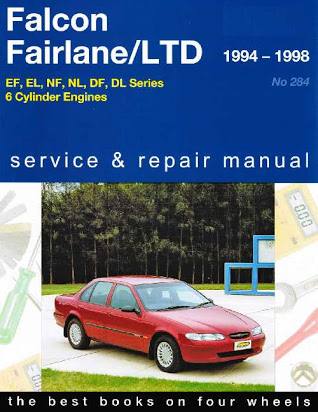Ford Falcon Fairlane LTD Ute Van EA EB ED LTD 1988 1995
|
Ford Falcon / Fairlane / LTD 1988 - 1995 Gregorys Owners Service & Repair Manual Covers: SOHC Petrol Engines Covered: Contents: NOTE: Only maintenance, adjustment, minor repair procedures plus removal and installation are described for the Transmissions. Note: Includes Wiring Diagrams Covering XG Series Longreach Utility and Van: Please also note: * XG Utility & Van are not completely covered. Engine & Running gear etc is the same as the sedan & wagon, but no body section for utility & van. * Covers Wiring for XG Utility & Van though.
|
The EA series was available in seven model variants: * Falcon GL Sedan * Falcon GL Wagon * Falcon S Sedan * Fairmont Sedan * Fairmont Wagon * Fairmont Ghia Sedan * Fairmont Ghia Wagon No commercial vehicle variants of the EA were developed and the existing XF Falcon utility and panel van both continued in production alongside the EA passenger vehicles. The result of a AU0 million development program, the EA Falcon bore a passing resemblance to the European Ford Scorpio. However under the skin, it remained an entirely Australian design, and is credited as the first Falcon model to employ wind tunnel testing. Developed under the codename EA26 (E for the large size, A for Australia, 26 for the global project number), it would retain the traditional Falcon hallmarks of width and rear-wheel drive. This proved to be the correct move as sales of the Falcon began to climb after the fuel crisis aftermath, while those of the rival Commodore slipped. It became clear that Australian buying patterns had not truly changed and what the public wanted was a full-size family car. In addition, Ford's dominance of the taxi market in Australia meant that a car that could comfortably seat three along the back seat—and even the front, with a bench seat installed—was necessary. It also ensured that Ford could retain, at least until Holden released the new Statesman/Caprice in 1990, the market for official cars for governmental use. While initially popular, the EA's build quality was uncompetitive with uneven panel shutlines, computer problems, poor paint quality and front suspension alignment problems. Launched in October 1989, the Series II brought with it a four-speed automatic transmission and body-coloured B-pillars. Despite the Series II models having significantly fewer problems than the Series I, Series II prices are also affected by curtailed resale values. The same problem also affects the NA Fairlane and DA series LTD, and even the utility and panel van variants, which continued with the older XF architecture.
Ford Falcon EB
The Ford EB Falcon is a car which was produced by the Ford Motor Company in Australia between 1991 and 1993. Visually the 1991 EB remained nearly identical to its predecessor. The most noticeable change was the transfer of the Ford emblem from the tip of the bonnet to the grille. Additionally the air vents in C-pillars had been abolished, and reversing lamps were featured on either side of the rear number plate. The return of the V8 engine was welcomed by the motoring press, however the 5.0 litre Windsor unit did not reappear in the utility variants until the "EF-shaped" XH series of 1997. There were also changes to the front suspension geometry, giving the EB a much better level of grip and steering feel. With the new model, Ford re-introduced the sports orientated GT specification level, an exclusive 250 unit run celebrating the 25th anniversary of the first original Falcon GT. The first XR6 and XR8 sports models appeared in the EB Series. The rarest model was the SS with just six produced. Five of which were absorbed immediately into production car racing. The radically different Series II model, appearing in showrooms in April 1992, saw the six-cylinder engine upsized by 35 cubic centimetres (from 3949 cc to 3984 cc). This brought the nominal total swept capacity to 4.0 litres. The transmission and electronics were also improved, and there were tweaks to the styling. The base model now had body-coloured bumpers, and the previously matte black plastic exterior door handles were now given a glossy finish. The update reportedly cost AU million. Innovation became an evident strength in the EBII: anti-lock brakes became an option, a Falcon first, and in 1993, a lap sash centre rear seatbelt became standard. The EB also introduced the "Smartlock" security locking system. South Australian Police revealed the operational success of "Smartlock", by inviting four professional car thieves to steal an EB specified with the locking system. The thieves were unsuccessful at their attempt, giving up after four days. Foam-filled A-pillars also featured, which greatly increased crush protection and stiffened the frame, thus helping to reduce Noise, Vibration, and Harshness.

 0 Items (Empty)
0 Items (Empty)












 >
>